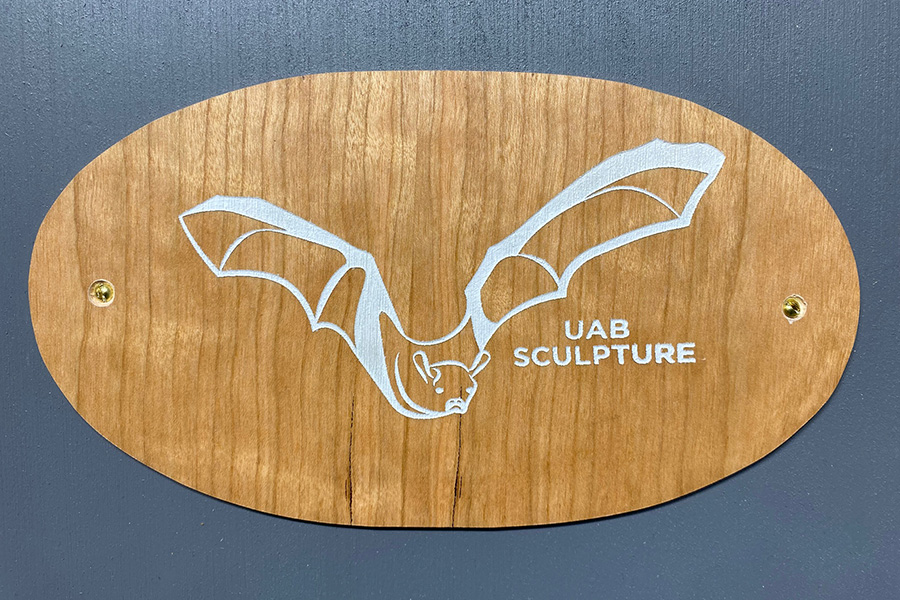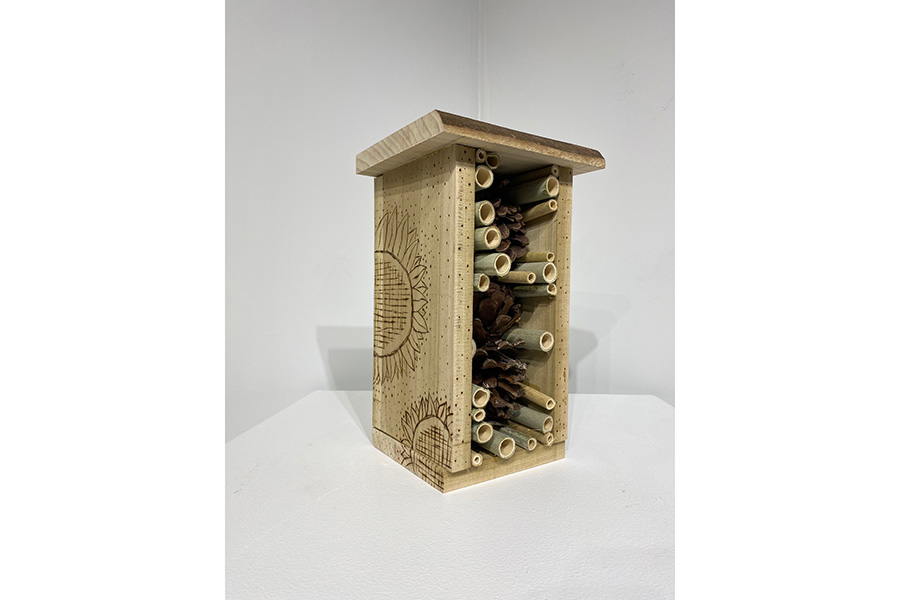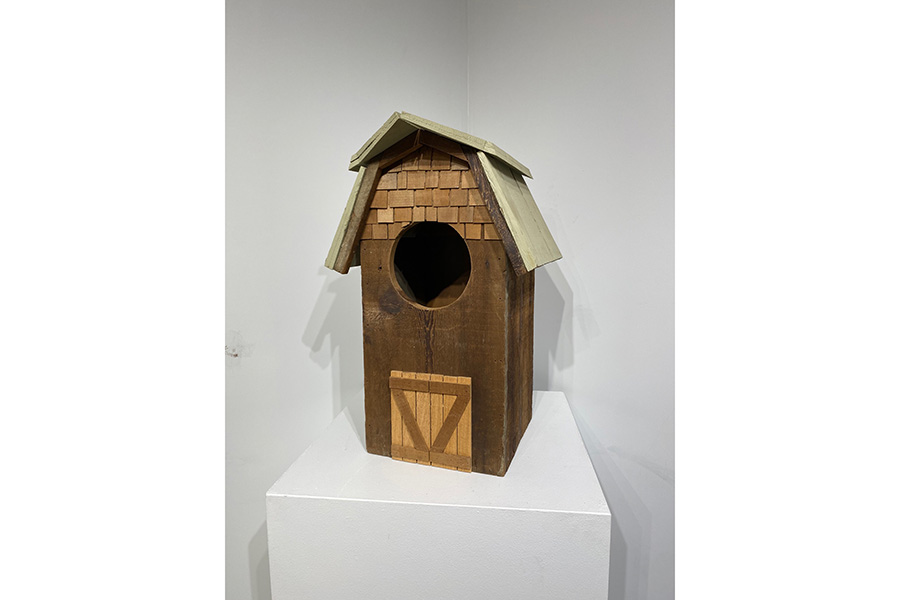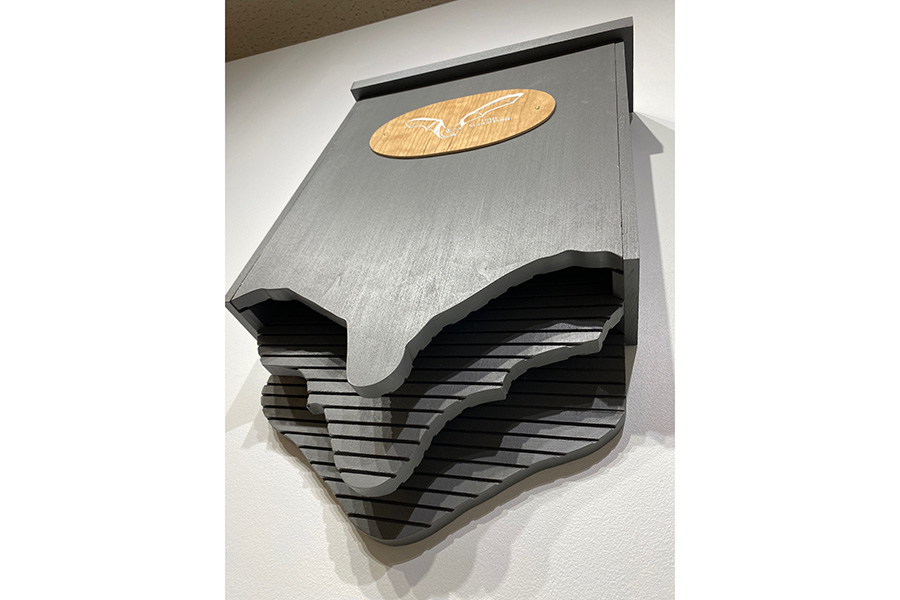 Students at the University of Alabama at Birmingham have built homes for local wildlife as part of their coursework.
Students at the University of Alabama at Birmingham have built homes for local wildlife as part of their coursework.
In a two-week sculpture assignment in the College of Arts and Sciences’ Department of Art and Art History, led by Associate Professor of Sculpture Stacey Holloway, woodworking students fabricated wildlife habitats for UAB Gardens as an exercise to practice carving, joinery and texture techniques.
The habitats — two bee condos, two bat houses and an owl house — will help wildlife populations thrive in local gardens and hopefully inspire members of the community to create their own gardens, staff say. Pollinators are essential to plant life, including for growing food for animals and humans.
The three students, Matthew Davis, Anne Kerr-Brown and Kylie Debardlebon, met with UAB Sustainability and got information on their needs. Each student designed their own habitat.
Bats play a key role in pollinating plants. As Sustainability expressed a need for bats in UAB Gardens, Holloway and UAB art lab supervisor and alumnus Jacob Phillips designed and built the bat houses, as they were more in-depth for the assignment timeline, using new digital equipment.
For UAB Sustainability, this project is a part of the greater effort to encourage wildlife habitat on campus, says manager Bambi Ingram. The houses will be installed in coming weeks.
“Since human activity has changed and eliminated habitat locally and globally, birds, butterflies and other wildlife are pushed into shrinking wilderness areas,” Ingram said. “UAB Sustainability is working to remedy this by creating a healthy and complex ecosystem in our urban environment on campus.”
UAB is a Bee Campus USA, which recognizes, supports and encourages pollinator conservation in towns, cities and counties across the country. Last spring, UAB installed two small beehives in the UAB Gardens to increase pollination in the area, which helps sustain Alabama’s native ecosystem. The hives, situated in a fenced area across from the UAB Solar House, joined an adjacent monarch butterfly habitat, which was built in fall 2020 to house milkweed plants and other nectar plants for monarch butterflies. A second monarch habitat at 10th Avenue South and 14th Street near Honors Hall was installed as part of a collaboration between Sustainability and the UAB Honors College’s Science and Technology Honors Program.
UAB Gardens, on the south side of campus, offers faculty and staff the opportunity to rent small plots to grow vegetables and fruits, backed by a mural painted by UAB art students and faculty. The gardens provide sanctuary for pollinators along with other areas in Birmingham, including:
- Ruffner Mountain Nature Preserve, a 1,038-acre urban nature preserve in Birmingham, the third largest in the United States.
- Avondale Habitat Garden, home to almost 100 species of native wildflowers, vines, shrubs and prairie grass, provides habitat for innumerable butterflies, bees, beetles and birds.
- Birmingham Eastside EcoGardens, a community garden with 100 different species of plants and herbs that attract pollinators, repair soil and are beneficial to wildlife.
At Ruffner Mountain’s Habitat Demonstration Gardens, visitors can stroll through gardens cultivated around the main entrance in a project designed and executed by UAB alumnus John Woolley in 2016.
“That project was an educational initiative to promote the use of native plants and wildlife habitat in urban spaces, and it inspired us to do this as a service project in the Contemporary Woodworking class,” Holloway said.
 The class’s research indicated that up to 50 percent of North American native bee species, most of which are solitary and stingless, have disappeared from their historic ranges in the last 100 years. Four of Alabama’s bumblebee species declined 96 percent in the last 20 years. Overuse of harmful pesticides and ecological homogenization are the drivers for the insect decline. Solutions are to create habitat, cultivate native plants and stop using pesticides.
The class’s research indicated that up to 50 percent of North American native bee species, most of which are solitary and stingless, have disappeared from their historic ranges in the last 100 years. Four of Alabama’s bumblebee species declined 96 percent in the last 20 years. Overuse of harmful pesticides and ecological homogenization are the drivers for the insect decline. Solutions are to create habitat, cultivate native plants and stop using pesticides.
Create your own wildlife habitats
One way to create habitat is with insect hotels. These structures are more of a permanent home for an approximately 11-month lifespan, from egg to larvae, to dormant pupa, and then to adult. If the right habitat conditions are met, the average garden can hold more than 2,000 different species of insects. Insect hotels provide shelter for solitary bees, wasps, lacewings, ladybugs, dragonflies, amphibians and reptiles.
Solitary bee habitats should include sufficient protection from elements, have a solid back structure, be approximately 8 inches deep, and have a variety of holes and crevices for nesting. Bees and wasps perceive dark colors as a threat, so a home should be painted white, tan, cream or gray. Hole sizes should be between 2 and 10 millimeters. Edges should be sanded, as splinters can damage delicate wings.
Bat houses should mimic the very narrow, tight space between the bark and a tree trunk. Leave the interior rough like bark for climbing. Paint the interior a dark color and caulk in the sides to keep heat in and provide warmth for babies. The size should be about 14 inches wide by 24 inches tall; place it at least 15 feet off the ground.
Butterfly houses should have slots that are 3/8 inch wide by 3 inches, to prevent predators from entering. A hinged door is handy for cleaning and for adding bark or twigs inside. Paint butterfly houses the color of native flowers, such as red, yellow, orange, pink or purple. All paint should be non-toxic, low-VOC exterior paint, and all glue should be water-based and on the exterior.




